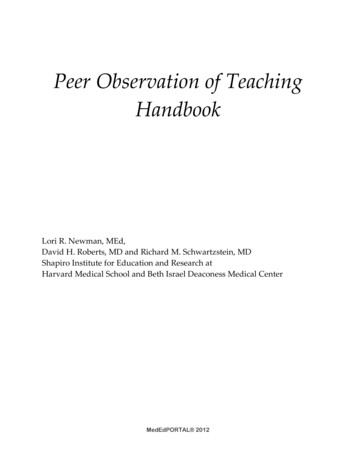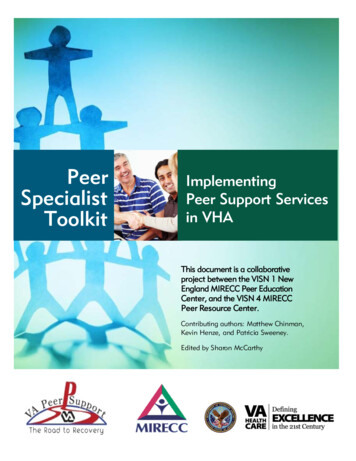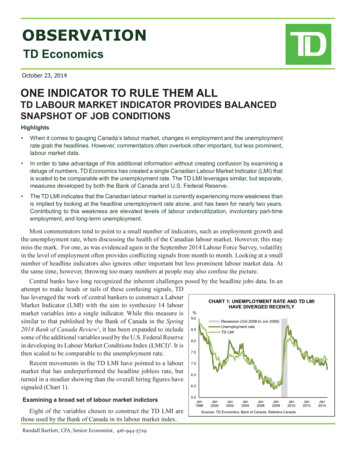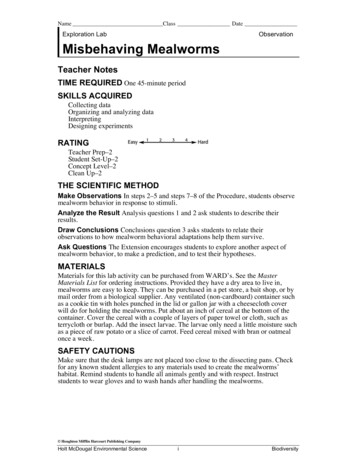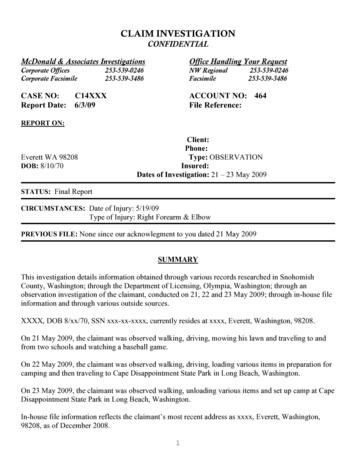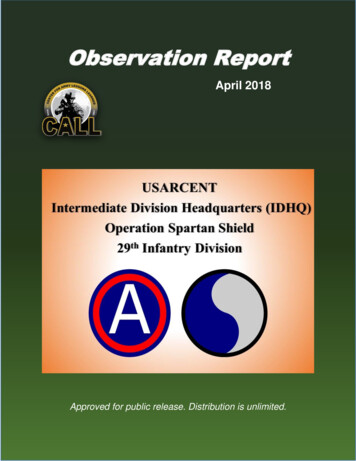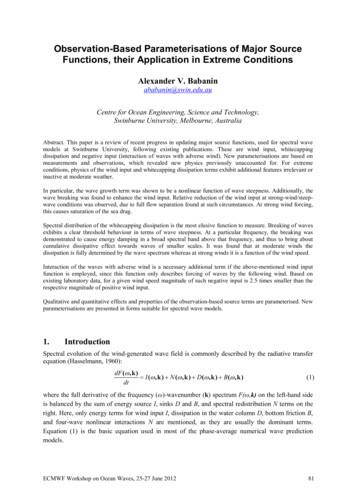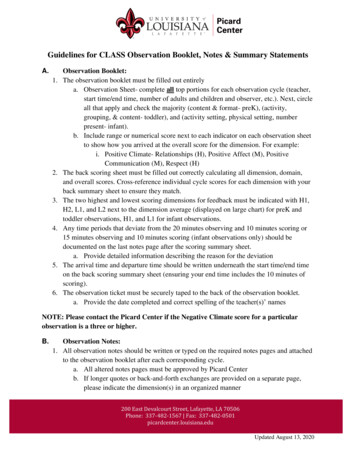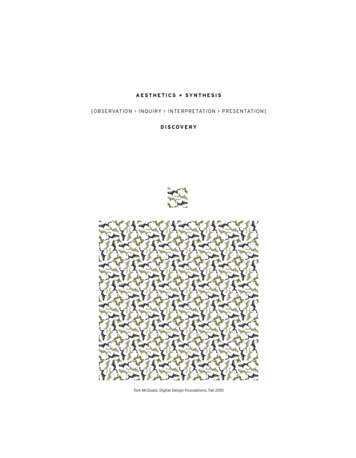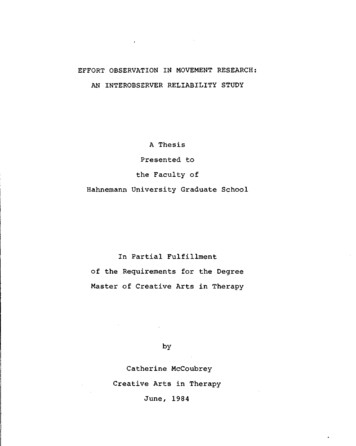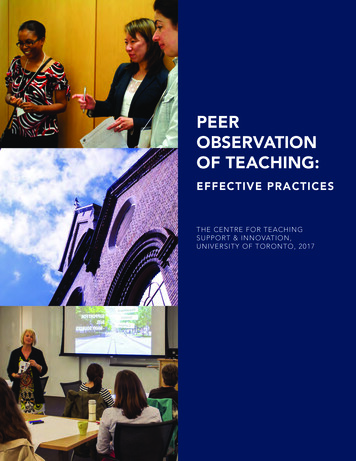
Transcription
PEEROBSERVATIONOF TEACHING:EFFECTIVE PRACTICESTHE CENTRE FOR TEACHINGSUPPORT & INNOVATION,UNIVERSITY OF TORONTO, 2017
PUBLISHED BYThe Centre for Teaching Support & Innovation (CTSI)University of Toronto130 St. George Street,Robarts Library, 4th FloorToronto, ON M5S 3H1Phone:Email:Website:(416) onto.caPlease cite this publication in the following format:Centre for Teaching Support & Innovation. (2017). Peer observation of teaching: Effective practices. Toronto, ON:Centre for Teaching Support & Innovation, University of Toronto.2.
CONTENTSPart I: Key Considerations – Rationale, Context and PrinciplesIntroduction . 1The Goals and Benefits of Peer Observation of Teaching. 2Three Models for Peer Observation. 2Setting the Context: Experiences with In-Class Observation at the University of Toronto . 3Online Observation: An Emerging Context . 4Peer Observation: Recommended Processes . 5Part II: Effective Processes and Practices for Peer ObservationChoosing an Observer. 8The Pre-Observation Consultation . 8Conducting the In-Class Observation. 8Using a Narrative Log. 9Self-Assessment. 9The Post-Observation Consultation .10Providing Meaningful Feedback on Teaching .11Sample Peer Observation Protocols.12One-to-One Classroom Observation.12Teaching Squares or Triads .14Peer Observation of Online Courses .13The Observation of Teaching for Summative Purposes .14Part III: Tools and Instruments for ObservationPre-Observation Template .16Observation Sample Templates .18The Narrative Log .18Open-Ended Form.19Checklist (Criterion-Based) Form . 20Online Course Evaluation Template. 23Post-Observation Debriefing Questions.25AppendicesAPPENDIX A: Additional Resources .26APPENDIX B: Best Practices for Classroom Visits .27APPENDIX C: Types of Questions to Ask/to Avoid .28References/Sources Cited. 30
PART I: KEY CONSIDERATIONS RATIONALE, CONTEXT AND PRINCIPLESIntroductionAs described by Chism (2007) in PeerReview of Teaching: A Sourcebook, peerreview of teaching is “informed colleaguejudgment about faculty teaching foreither fostering improvement or makingpersonnel decisions” (p. 3). Peer reviewof teaching is a broad concept thatincludes an array of practices, includingthe assessment of teaching dossiers,syllabi, assignments, student and courseevaluations, personal reflections, and peerobservation. Peer review of teaching isused for both summative and formativepurposes.Summative peer review of teaching isgeared towards generating informationneeded to evaluate teaching for humanresource-related purposes (e.g., tenureand promotion). As summative reviewsare evaluations with a defined purpose inmind, they tend to cover broad categories,and offer a comparison to peers. Formativeassessment, in the context of the peerreview of teaching, refers to activitiesand processes that provide instructorswith specific feedback that they canuse to improve their teaching practice.The feedback generated from formativeassessment is intended to provideinstructors with robust and detailedinsights into their teaching. As Chismstates, formative assessment of teaching is“the basis for the development of effectiveteaching throughout one’s career” (p. 5).Peer observation, for both summativeand formative purposes, is an importantcomponent of the peer review of teaching.In general, collaborative peer observationof teaching is comprised of three steps:1. a pre-observation conference;2. an in-person classroom visit (oronline observation, in the case ofonline courses) during which detailedobservations of the instructor’spractice (including classroomenvironment and student interactions)are captured via a template or rubric,and through narrative notes; and,3. a post-observation conference thatincludes both self-reflection on thepart of the observee and constructivefeedback from the observer (Wilkerson& Lewis, 2002, p. 75).There are many models of peerobservation, and emerging models ofthe observation of online courses. Theprimary focus of this guide is formativepeer observation of teaching at theUniversity of Toronto, including inonline courses. The guide presentsdifferent models of peer observationand assessment that can be adapted tomultiple contexts across the institution,providing tools and instruments for peerobservation of teaching, and offering anoverview of how to best use them.Although focused on formativepractices, the guide outlines how theseprocesses differ from those used forsummative purposes, and describeshow these practices might be adaptedas departments carry out summativeobservations of teaching for tenureand promotion purposes, as includedand outlined in some U of T divisionalguidelines for the assessment of teachingfor tenure and promotion.“[FORMATIVEEVALUATION IS]THE BASIS FOR THEDEVELOPMENT OFEFFECTIVE TEACHINGTHROUGHOUT ONE’SCAREER.”(Chism, 2007, p. 5)1.
“ A PROCESS WHEREBY A TEACHER PARTICIPATES AS AN OBSERVER IN A LESSON TAUGHTBY A COLLEAGUE FOR THE PURPOSES OF EXPLORING THE LEARNING AND TEACHINGPROCESS AND ENVIRONMENT AND WHERE THIS ‘OBSERVATION’ LEADS ON TO REFLECTIONAND DISCUSSION, WITH THE UNDERPINNING LONG-TERM AIM OF IMPROVING STUDENTS’LEARNING.”(Bennett & Barp, 2008, p. 559)The Goals and Benefits of Peer Observation ofTeachingPeer observation of teaching in higher education hasbeen used and evaluated both as a faculty developmenttechnique and a summative evaluation tool for severaldecades. Studies highlight the value of the practice as away of foregrounding the teaching and learning process,making teaching practice visible, and improving thequality of teaching and student experiences (Fullerton,1993; Hammersley-Fletcher & Orsmond, 2004; Martin &Double, 1998; Pressick-Kilborn & te Riele, 2008). Bennettand Barp (2008) summarize the process and outcomes ofpeer observation as follows: a process whereby a teacher participates asan observer in a lesson taught by a colleaguefor the purposes of exploring the learning andteaching process and environment and where this‘observation’ leads on to reflection and discussion,with the underpinning long-term aim of improvingstudents’ learning. (p. 559)Martin and Double (1998) identify the six main aims ofpeer observation as:123456improving or developing an understanding ofpersonal approaches to curriculum delivery;enhancing and extending teachingtechniques through collaboration;exchanging insights relating to the review ofteaching performance;expanding personal skills of self-reflectionand evaluation;developing curriculum planning skills incollaboration with peers and colleagues; and,identifying areas in teaching practice withparticular merit or in need of development.Sullivan, Buckle, Nicky, and Atkinson (2012) furtherenumerate the practical benefits of peer observation,stating that the process can additionally reaffirmteaching skills, provide developmental feedback andultimately maintain high standards in undergraduateteaching, for example. Peer observation in itscollaborative approach may also play a role incontributing to strong departmental teaching climatesand cultures (Smith, 2013).Three Models for Peer ObservationA review of the literature demonstrates that there arethree basic models of peer observation of teachingusually conducted within higher education institutions.Gosling (2002) captures these models as follows: 1)an evaluation model, where the primary purpose isto provide summative feedback for the purposes ofappraisal or quality assurance; 2) a developmentalmodel where the overarching goal of observationis improving teaching and learning; and 3) the peerreview model, where self- and mutual- reflectionare emphasized, resulting in formative feedback. Asdescribed by Siddiqui et al. (2007), the “essence of thepeer-review model is that teachers observe eachother, often in a reciprocal process” (p. 297).Several studies demonstrate how the peer review modelfor the observation of teaching provides faculty withopportunities for development, and improves teachingpractice (Bell 2001; Hendry & Oliver, 2012; Sullivan et al.,2012). Hendry and Oliver (2012) write that “observing acolleague teach can both show the observing teachershow new strategies work and enhance their confidenceto apply them in their own teaching” (p. 1), and Sullivanet al. (2012) show how the peer observation of teachingcan provide “an opportunity to examine both contentand delivery of individual course components so thatsuggestions could be made as to how these might beimproved or refined” (p. 3).2.
Other benefits include first-hand collegial support andthe growth of teaching-related collaboration (PressickKillborn & te Riele, 2008). Throughout the process,peer observation can act as a valuable opportunity forreflection, give insight into teaching practices, mutualprofessional development, and quality improvement inteaching and learning (Sullivan et al., 2012).Setting the Context: Experiences with In-ClassObservation at the University of TorontoIn a recent report on faculty mentoring for teachingpractices at the University of Toronto, the Centre forTeaching Support & Innovation (CTSI) intervieweda range of faculty members who described peerobservation of teaching experiences. Several facultymembers interviewed described occasions in whichpeers from within and outside their department soughtfeedback on their in-class teaching. For example, aparticipant in a department in the Physical Sciencesdescribed a lengthy history of peer support for in-classobservations that are further enhanced by includingstudents in the formative assessment process. In theirpaired interview with CTSI, participants reflected onthe value of this activity and support for observing oneanother’s teaching to gain new insights on strategies,approaches, and educational technologies. A strongteaching culture in this
Online Course Evaluation Template 23 Post-Observation Debrieing Questions 25 Appendices APPENDIX A: . teaching and a report on the in-class observation be provided to the review committee. Leading up to this observation, participants reported, there can be little . to no preparation for or feedback on in-class teaching. Preparation in such cases might include a formative “check-in” prior .
